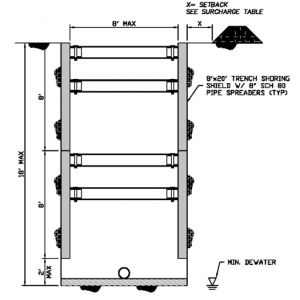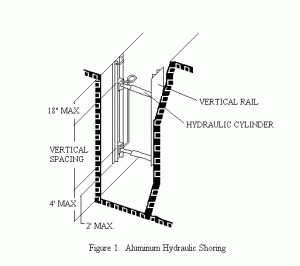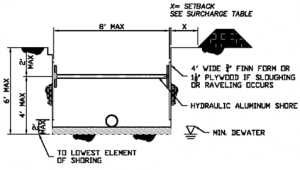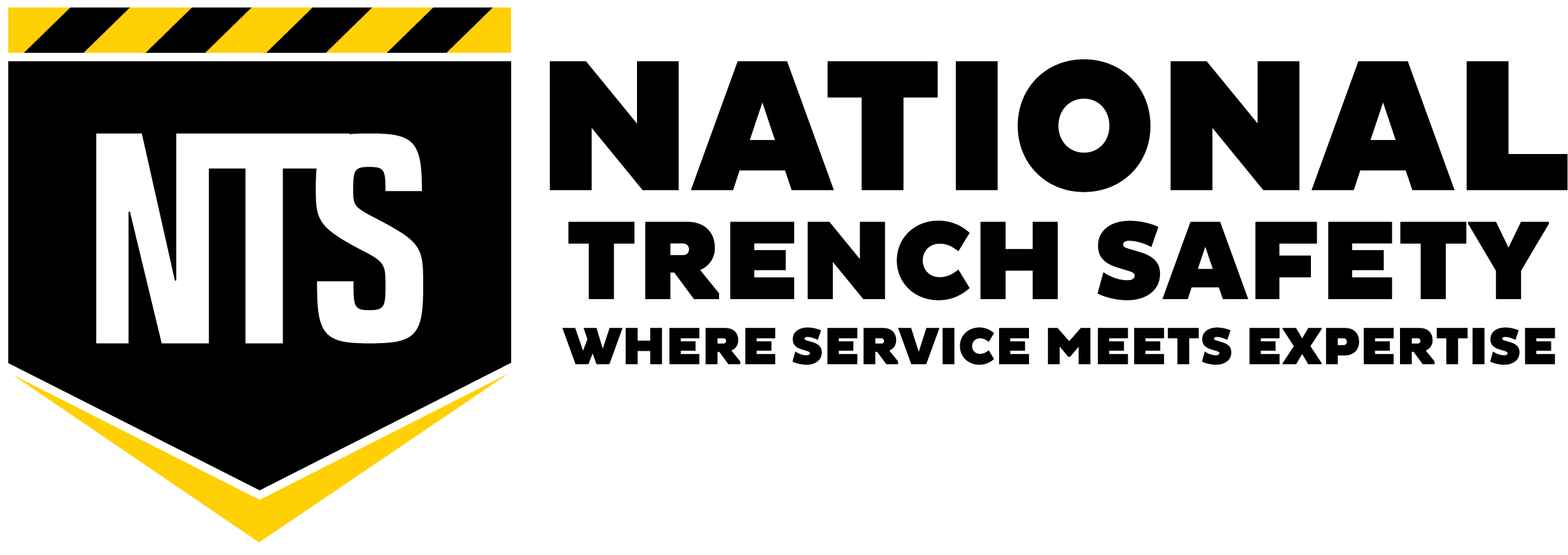There are many requirements within OSHA Subpart P that may not be entirely clear. One requirement that I continually get questions on is what we call the” 2-ft rule”. The 2-ft rule provides that a protective system, such as shoring shields and hydraulic shores, cannot be held more than 2-ft off the bottom of an excavation. Here is a brief history and what I know about this requirement.
My experience with this rule begins with the clause below which was the original OSHA Subpart P promulgated in 1971:
(iii) excavations below the bottom of sheeting, trench shields, or trench boxes, … excavation up to 2-ft below the bottom is permitted provided …. Soil in that area cannot move … and soil loads to the bottom of the excavation are designed for…
From 1976 to 1980 OSHA had a study done to examine the effectiveness and understanding of Subpart P followed by, in 1981, five regional workshops of industry stakeholders to examine changes to the language. At the time, there was a proposal to change the 2-ft rule to a 3-ft rule for temporary applications. It turns out that most everyone agreed, except the San Francisco region. As those working in San Francisco will know, the area has pure sand on the west side and “Bay Mud” on the bay side so there were concerns about clays flowing and sands collapsing under sheeting held more than 2-ft off the bottom.
It took eight more years after the public comment period to adopt the final version of Subpart P in late 1989.
It took eight additional years after the public comment period to adopt the final version of Subpart P in late 1989. The OSHA 2-ft rule now states :
1926.652(e)(2) Additional requirements for support systems for trench excavations.
1926.652(e)(2)(i)
Excavation of material to a level no greater than 2 feet (.61 m) below the bottom of the members of a support system shall be permitted, but only if the system is designed to resist the forces calculated for the full depth of the trench, and there are no indications while the trench is open of a possible loss of soil from behind or below the bottom of the support system.
1926.652(g)(2)
Additional requirement for shield systems used in trench excavations. Excavations of earth material to a level not greater than 2 feet (.61 m) below the bottom of a shield shall be permitted, but only if the shield is designed to resist the forces calculated for the full depth of the trench, and there are no indications while the trench is open of a possible loss of soil from behind or below the bottom of the shield.
Now fast forward to 1987 in Sacramento, California. I had developed a slide-rail shoring plan for a pipeline project. The trench was 30-ft deep in very dense sands, gravels, and cobble. The contractor was destroying the slide-rail panels trying to drive them down the last 4-ft, so I changed the allowable depth of the panels off the bottom to 4-ft for the project. At the time I thought that I could do this under a site-specific plan. The project engineer objected due to the OSHA “2-ft rule”. Ultimately the disagreement led to a four hour discussion with a California OSHA regional director discussing the interpretation of the rule. He explained some very important things to me about this rule:
- Both 1926.652(e)(2) and 1926.652(g)(2) state that there are “additional requirements” to both tabulated data and site-specific shoring plans and cannot
 be changed or removed through notes on the tab data or site-specific engineered plan.
be changed or removed through notes on the tab data or site-specific engineered plan. - These rules were part of Subpart P and could not be changed by anyone within OSHA because they do not have the power to write or change the law. The only way we could get it changed was to be cited for violating it and take it through the court process to get a judgment interpreting it differently than the way Cal OSHA had interpreted it. It was highly unlikely that the court would find a compelling reason to interpret it differently, so we did not pursue it.
- I also asked him “why could an additional couple of feet not be allowed if an engineer calculated it was safe, as it clearly was in the case of our project?” His response was, “where is the limit, next you will be asking for 8-ft and then 20-ft. We like it this way because there is a strict limit to what can be left un-shored at the bottom of a shored excavation.”
Since that meeting, I have been asked many times over by contractors to allow trench shoring to be allowed more than 2-ft off the bottom, in most cases because it was practically impossible to get the shield or sheeting down any further and when talking to a client I always advise them that based upon my experience, OSHA may object to such a plan.
The rule is fairly definitive about shields and sheeting but it is a little less clear when it comes to aluminum hydraulic shoring. The general rule for trench jacks is that the first  cylinder must be within 4-ft of the bottom of the trench and 18-in of the top, (2-ft of the top when using manufacturers tabulated data). Sheeting is only required if sloughing or raveling are occurring. It is fairly clear that due to the 2-ft rule the sheeting must reach within two feet of the bottom. The question always comes up as to how does the rule apply when sheeting is not required. Single cylinder hydraulic shores have a rail that is typically 12-in to 18-in below the cylinder. Generally speaking, 5-ft and 7-ft hydraulic shores also have a rail that extends less than 2-ft below the cylinder. In all of these cases, if sheeting is not used the lowest element of the shore, the rail, must be within 2-ft of the bottom of the trench. From an engineering perspective, the rail is not a structural element of a hydraulic shore, the rail just holds the cylinders in place and keeps them from punching into the soil. In 2007 I had a meeting with a very high-ranking Cal OSHA official on this topic. He started the conversation by stating, that he was pleased to talk about it provided that I did not tell him that the rule made no sense because it was there and it was not going to be changed anytime soon. I think he had heard the nonsense argument too many times before. He said it was simple, “just make sure something on the trench jacks is within 2-ft of the bottom of the trench and we will leave you alone. “
cylinder must be within 4-ft of the bottom of the trench and 18-in of the top, (2-ft of the top when using manufacturers tabulated data). Sheeting is only required if sloughing or raveling are occurring. It is fairly clear that due to the 2-ft rule the sheeting must reach within two feet of the bottom. The question always comes up as to how does the rule apply when sheeting is not required. Single cylinder hydraulic shores have a rail that is typically 12-in to 18-in below the cylinder. Generally speaking, 5-ft and 7-ft hydraulic shores also have a rail that extends less than 2-ft below the cylinder. In all of these cases, if sheeting is not used the lowest element of the shore, the rail, must be within 2-ft of the bottom of the trench. From an engineering perspective, the rail is not a structural element of a hydraulic shore, the rail just holds the cylinders in place and keeps them from punching into the soil. In 2007 I had a meeting with a very high-ranking Cal OSHA official on this topic. He started the conversation by stating, that he was pleased to talk about it provided that I did not tell him that the rule made no sense because it was there and it was not going to be changed anytime soon. I think he had heard the nonsense argument too many times before. He said it was simple, “just make sure something on the trench jacks is within 2-ft of the bottom of the trench and we will leave you alone. “
In all fairness to OSHA, these are some good points. Soil flowing out of a gap between the sheeting can be very dangerous. There was a case where two carpenters cut a 2-ft  x 2-ft hole in a timber lagged wall to allow a pipe to come through. The soil flowed out and buried them. I believe that if not for the 2-ft rule, we would commonly see protective systems held 2-ft to 5-ft off the bottom today, exposing workers to extra risk in the trench. In 2007 the Federal Government conducted a “regulatory review of 29 CFR 1926, Subpart P: Excavations. In that review, it was determined that the number of violations issued for fatalities associated with 1926.652(e)(2) Additional requirements for support systems for trench excavations was 26; with 12 listing the reference as contributing to the fatality during the 1990-2000 period. One life lost is too many so the rule is significant and should be respected.
x 2-ft hole in a timber lagged wall to allow a pipe to come through. The soil flowed out and buried them. I believe that if not for the 2-ft rule, we would commonly see protective systems held 2-ft to 5-ft off the bottom today, exposing workers to extra risk in the trench. In 2007 the Federal Government conducted a “regulatory review of 29 CFR 1926, Subpart P: Excavations. In that review, it was determined that the number of violations issued for fatalities associated with 1926.652(e)(2) Additional requirements for support systems for trench excavations was 26; with 12 listing the reference as contributing to the fatality during the 1990-2000 period. One life lost is too many so the rule is significant and should be respected.
One ambiguous area in the rule that one may encounter is that it is written for trenches and not excavations. The OSHA defines trenches differently than excavations; however, with trenches the rule is clear. It is probably best practice to interpret the rule similarly or to seek the opinion of an OSHA representative to clarify the rule.
Another case where there is confusion is where there is soil over solid rock. I have engineered several excavations where the contractor shored several feet of soil and then when they encountered very solid rock they discontinued the shoring and cut vertical several more feet. In this case, shoring is definitely held more than two feet off the bottom of the trench, technically in violation of the rule. The rule makes it ambiguous here because it is an odd case that does not fit the situation. The rock was lava flow and definitely solid, I have also done it with solid granite but in all cases of rock it should be certified by an engineer to be solid, or else it should be shored.
As I stated at the start of this, I am asked about the 2-ft very often. There is no choice but to adhere to it. Do not stop the sheeting more than 2-ft off the bottom of the excavation or put workers in the excavation until it is in place.
About the Author: Joe Turner, P.E. serves as National Trench Safety’s Director of Engineering, Research, and Product Development. Mr. Turner is one of the most recognized figures in the trench safety industry, having provided trench safety plans for the last 20 years. Among his many accomplishments, is the book Excavation Systems, Design, Planning and Safety, which was published by McGraw-Hill in 2008 and is still used today as a reference for many students and professionals regarding proper engineering techniques.
DISCLAIMER: the information contained in this article is provided for general and illustrative purposes only and is not to be considered Site Specific and or designated engineering for any project or work zone, nor is it to be used or consider to be tabulated data, technical data, advice and or counsel to be used on any job site. Each project is different and is the responsibility of the employer’s designated Competent Person to make decisions upon what systems and methods may be used in compliance with the federal and local regulations, manufactures tabulated data, engineered drawings, and other plans.





